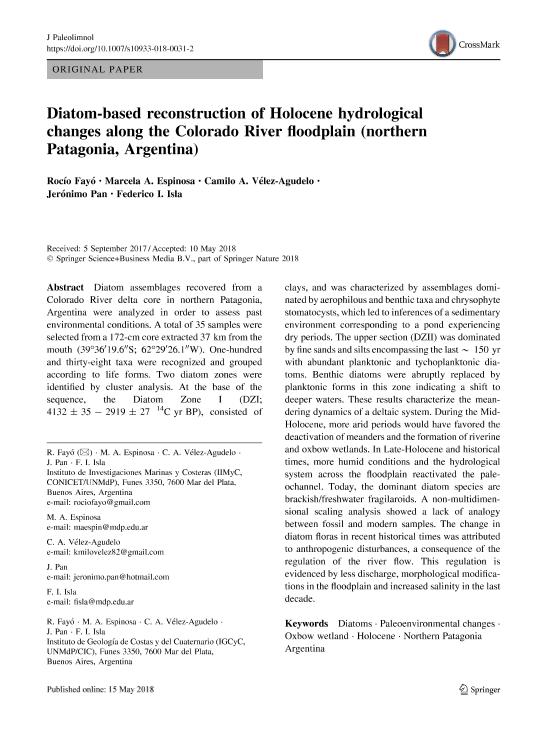Artículo
Diatom-based reconstruction of Holocene hydrological changes along the Colorado River floodplain (northern Patagonia, Argentina)
Fayó, Rocío ; Espinosa, Marcela Alcira
; Espinosa, Marcela Alcira ; Vélez Agudelo, Camilo Andrés
; Vélez Agudelo, Camilo Andrés ; Pan, Jeronimo
; Pan, Jeronimo ; Isla, Federico Ignacio
; Isla, Federico Ignacio
 ; Espinosa, Marcela Alcira
; Espinosa, Marcela Alcira ; Vélez Agudelo, Camilo Andrés
; Vélez Agudelo, Camilo Andrés ; Pan, Jeronimo
; Pan, Jeronimo ; Isla, Federico Ignacio
; Isla, Federico Ignacio
Fecha de publicación:
10/05/2018
Editorial:
Springer
Revista:
Journal Of Paleolimnology
ISSN:
0921-2728
Idioma:
Inglés
Tipo de recurso:
Artículo publicado
Clasificación temática:
Resumen
Diatom assemblages recovered from a Colorado River delta core in northern Patagonia, Argentina were analyzed in order to assess past environmental conditions. A total of 35 samples were selected from a 172-cm core extracted 37 km from the mouth (39°36′19.6″S; 62°29′26.1″W). One-hundred and thirty-eight taxa were recognized and grouped according to life forms. Two diatom zones were identified by cluster analysis. At the base of the sequence, the Diatom Zone I (DZI; 4132 ± 35 − 2919 ± 27 14C yr BP), consisted of clays, and was characterized by assemblages dominated by aerophilous and benthic taxa and chrysophyte stomatocysts, which led to inferences of a sedimentary environment corresponding to a pond experiencing dry periods. The upper section (DZII) was dominated by fine sands and silts encompassing the last ~ 150 yr with abundant planktonic and tychoplanktonic diatoms. Benthic diatoms were abruptly replaced by planktonic forms in this zone indicating a shift to deeper waters. These results characterize the meandering dynamics of a deltaic system. During the Mid-Holocene, more arid periods would have favored the deactivation of meanders and the formation of riverine and oxbow wetlands. In Late-Holocene and historical times, more humid conditions and the hydrological system across the floodplain reactivated the paleochannel. Today, the dominant diatom species are brackish/freshwater fragilaroids. A non-multidimensional scaling analysis showed a lack of analogy between fossil and modern samples. The change in diatom floras in recent historical times was attributed to anthropogenic disturbances, a consequence of the regulation of the river flow. This regulation is evidenced by less discharge, morphological modifications in the floodplain and increased salinity in the last decade.
Archivos asociados
Licencia
Identificadores
Colecciones
Articulos(IIMYC)
Articulos de INSTITUTO DE INVESTIGACIONES MARINAS Y COSTERAS
Articulos de INSTITUTO DE INVESTIGACIONES MARINAS Y COSTERAS
Citación
Fayó, Rocío; Espinosa, Marcela Alcira; Vélez Agudelo, Camilo Andrés; Pan, Jeronimo; Isla, Federico Ignacio; Diatom-based reconstruction of Holocene hydrological changes along the Colorado River floodplain (northern Patagonia, Argentina); Springer; Journal Of Paleolimnology; 60; 3; 10-5-2018; 427-443
Compartir
Altmétricas



